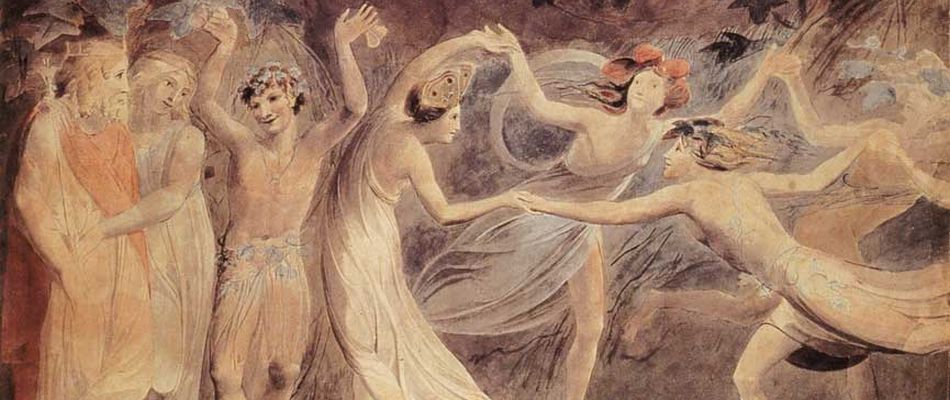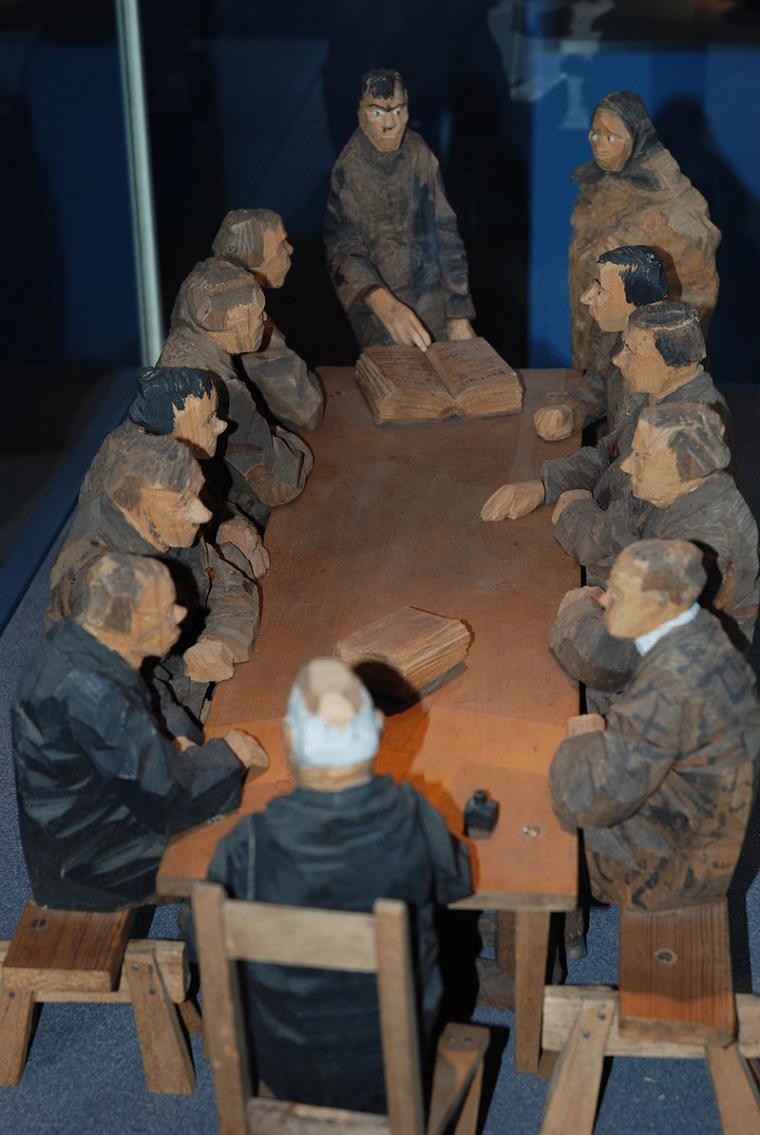Art: Döderhultarn and the Theatre of Life
Häradsrätten / The County court. (Ca. 1910) Döderhultar & Søfartsmuseet Oscarshamn. Picture by Anne-Marie Rasmussen.
God has always been hard on the poor.
Jean-Paul Marat
Personality, technique and motifs
Statuette-carver Axel Robert Petersson, dubbed “Döderhultarn'' after his birthplace, lived most of his creative life from 1868 to 1925 in the town Oskarshamn, province Småland, south-eastern Sweden.
He was a peasant’s son, and had some basic education in woodcarving, but according to himself this only did benefit his development, as it made him weary of wasting time hyper-polishing figures, and he soon ventured on in his own quiet, queer ways.
In his formative years he had no connection with established artists whatsoever, and thus seems to have been a developed artist and craftsman by disposition.
The extraordinary thing is that he all by himself reshaped Nordic wood carving, both in form, by introducing the technique of flat-carving, and in subject-matter, as social commentary. In those projects he had no precursors or role-models, which makes him the emblematic village genius.
He was not attracted to the lights of the big city and preferred quiet contemplations by his provincial fireside. If neighbours in Oskarshamn considered him an oddball, so be it. The self-confidence of this little eccentric man was rightfully substantial. This art is very small in shape, but great in significance.
Motifs were found in the rural life of his home county. Peasants and animals are gestaltet somewhere between rough naturalism and crass expressionism. These small sculptures are true caricatures, reporting from the poor man’s and poor animal’s world. Axel Petersson indeed had a keen eye and a sharp knife for weaknesses and injustices.
We may be fairly sure the artist didn’t have a reform program and was politically indifferent - or independent. Matching this independence, we have reasons to believe that he was neither religious nor a-religious. We may come to agree, that underneath a somewhat cynical mask, his art was motivated by a compassion with the meek and the weak, animals and humans alike.
I will not deal with his rather unspectacular life and somewhat odd opinions, nor his luck to be recognized in the right time, as this is well documented.
Instead I will proceed to take a closer look at one tableau of statuettes in order to characterize Döderhultarn’s vision of man in this Swedish province around 1900. I have chosen a piece named “Häradsrätten” i.e. The County Court; a scene depicted at least two times.
But first some impressions of a Swedish province.
An unkind landscape
In the 1880-ties one of my great-grand fathers came to Denmark from Småland, where poor peasants, according to what my Mum told me, used to mix birch-bark in the flour – not because of the pleasant taste.
In the bright Smålandish summertime, between consumption of coffee and "kanelbullar" in this merry and tourist-friendly Astrid Lindgren-land, visitors might not have anotion of how much sour sweat it once, before cheap oil and modern technology, took to make a modest living around here.
A few hours’ travel through enormous - I’m sorry to say: plain boring - wood-fields, where the Swedes cultivate timber, fire-wood, blueberries and moose; blue lakes and picturesque red wooden cabins pass by, and one slowly gets aware of the dwarvish fields where grass is harvested, added by potatoes, barley and perhaps a little oat.
On a full stomach one tends to forget that life in the old days, more often than not, was unpleasant, short and unjust.
“Småland” means “small lands”, which probably refer to the scattered homesteads and villages of the province. This landscape is not really gay and friendly. There´s a lot of unkind granite underneath.
At these sights I came to understand why my ancestor Hans Olsson fled from the thin soils around his home-village. No wonder that a very great number of peasants from these areas emigrated to more prosperous parts of the world in the years before World War 1, mostly the USA and Canada.
The background for Döderhultarn’s art is the scarce resources of Småland’s rural life, where social control was harsh and soul and body not much more than puppets on the threads of law, religion and customs.
The puppet-master and his tools
Axel Petersson was sort of a puppet-master, and we are spectators to his little theatre where he displays folksy scenes, well-known to contemporaries. They are tableaux which depicts both real life and collective notions of how people treated each other in days gone by.
Weather Mr. Petersson has witnessed the different situations he shows, we cannot know. As an artist he is both embedded in and transcends the milieu. As an eccentric or individualist, he was (probably not without some costs) able to distance himself from society and thereby establish an aesthetical space where he recorded facts from human life, according to his vision.
The artist carves (and paints) wood in shape of bodies in movement and position. A certain space and time is made manifest by reducing the raw material. This local space-time made out of wood is visible in texture, proportions and colour. Movements and interactions are simulated in mimic, gestures, positions, stability etc. which communicate emotions, status-relations and intentions.
The statuettes express something about life’s qualities because they operate within a certain set of conventions. These conventions are presupposed mental frames for production and reception of the portraits and genre-pictures. Thus the wooden statuettes refer to actual situations and characters, and make social and cultural topics, manifest in a distinctive personal style.
Please scroll up and take a closer look at the tableaux in Häradsrätten.
Description of Häradsrätten
A group of people are gathered around a long table, upon which are placed two books, two pieces of paper (sketched on the table), and an ink-bottle to the right of the person in the foreground. The nine of them are sitting on long-banks. The only woman in the group has a baby wrapped in blankets in her arms, which makes the number of persons 13.
She is looking at the man standing beside her, as he stares in the distance.
He has placed two fingers on the open book. The persons at the long sides are positioned rather relaxed. The judge sits at the opposite end of the table. As the only one he wears a pair of spectacles and has his own chair. He definitely is the chairman.
Paternity
Until a few decades ago a man was unable to know for certain whether he really was the father of his children, or not. This general disadvantage was an advantage for crooks who wanted to get away from the responsibility of raising a child. A question of paternity was to a proportion determined by the (lack of) conscience and selfishness of the man. The Swedish state’s remedies and enthusiasm for proving right from wrong in paternity cases in those days were as insufficient as in biblical times. We witness the moment before a not-so Solomonic verdict is cast and put down in binding words.
Allusions?
By showing 13 people situated around a long table the artist possibly alludes to the tale of The last Supper. The standing man takes an oath upon the holy bible, and swears by his soul, that he is not the father of the child. He obviously is a traitor and liar, a Judas. As he performs this speech-act, he stares out in the open space behind the committee, to freedom or despair in something or nothing.The young (ex-) couple’s eyes are the ones whose directions of looking are made most manifest.
Respect is a relation between persons. The term is derived from Latin ``re-spes” – to look back. A respectful relation is a practising of mutual acknowledgement by looking at each other. The young male doesn’t look at anybody, which shows lack of respect for this court – or that he doesn’t dare to look at anybody, as he is lying. He probably knows he isn’t worth the court’s respect either, which it consequently doesn’t give him by not looking at him in the defining moment.
The young woman stares at him. She is losing respect for him, betrayed by the one she once loved.
Consequently she can be placed into Jesus’ position in the drama. She is sacrificed because the man, according to procedure must and will be salvaged, by his peers. The child, hidden in a shawl, is the burden she has to bear beside the name whore, denounced as she is by both her former lover and the state. Her future will most likely be a fight for the necessities of life and self-respect, as she has lost the others’. The court adds injustice to injury.
Summum jus, summa injuria: the highest justice is the highest injustice.
The fate of these three individuals, who from now on not will be a family, is determined by a magical ritual involving the Bible.
The nine laymen in the court (acting as a parenthood committee) partakes a judicial proceeding, which they seemingly are having no reservations about. We may be inclined to think these gentlemen don’t give a damn about the misery of young women.
There is a almost freezing coolness in the scenery. Although the group in the court-scene are shaped as distinctive individuals, they act as a body and show no signs of mercy or compassion.This is the power of indifference.
The participants are actors in an tragedy, where positions, gestures, artifacts, relations &c, are visible elements of a social structure, gets into the day when we’re witnessing it, by our own imaginative participation. The depiction of this Court is the actual social power-structure made manifest.
In this case women (and children) are something which can be dispensed of.
A parable in wood
The "Häradsrätten" statuettes express a realistic approach to power-relations in contemporary Sweden, especially between the sexes, channelled through a legal procedure. The scene is Döderhultarn’s vision of and testimony on the rules and ideology of his society, and what women may expect of the male sex and its law.
A society should be judged by the way it treats its weakest members. Indifference is mercilessness; mischief and coolness in human relations are shaped by and codified in the cool and rigid procedures of this provincial court. The misery and façade of public morale and justice is for all to see - through.
This little unpretentious group of statuettes tells a story about betrayal, lukewarmness and suffering. A parable told, not in words, but in wood, concerning the human condition of yesterday, today and possibly tomorrow.
No bread and wine upon the table, only ink, books and paper. This may be the body and soul of the Court, but that's not spiritual food for ordinary people.
Godness “is” in the scene, virtually, as a possibility, something we might wish for.
The tableau despicts a Court whithout jurisprudence: knowledge of how to tell right from wrong. It's a rubber-stamp machine in a godforsaken Swedish province.
Exit
Mr. Petersson for his part came to prefer a bachelor's independence in provincial solitude, and fulfilment in hard labour, fuelled by strong coffee and sips of opium-tincture for acquaintance, conformity, marriage, politics or religion.
As he by luck and tenacity got famous and comfortable, he cherished renting a flying machine (with pilot!) in the summertime and criss-cross the skies over Småland.
It might have been religion in these early days of aviation.
About Axel Petersson Döderhultarn:
http://www.enigma.se/AP/Museet.htm
http://en.wikipedia.org/wiki/Axel_Petersson_D%C3%B6derhultarn

